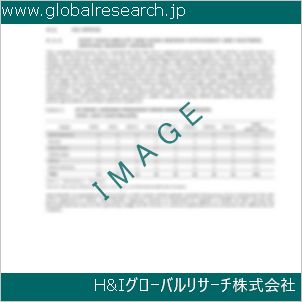Table of Contents
1 Industry Overview of Berylliumacetate
1.1 Definition and Specifications of Berylliumacetate
1.1.1 Definition of Berylliumacetate
1.1.2 Specifications of Berylliumacetate
1.2 Classification of Berylliumacetate
1.3 Applications of Berylliumacetate
1.3.1 Nuclear Application
1.3.2 Non-Nuclear Application
1.4 Industry Chain Structure of Berylliumacetate
1.5 Industry Overview and Major Regions Status of Berylliumacetate
1.5.1 Industry Overview of Berylliumacetate
1.5.2 Global Major Regions Status of Berylliumacetate
1.6 Industry Policy Analysis of Berylliumacetate
1.7 Industry News Analysis of Berylliumacetate
2 Manufacturing Cost Structure Analysis of Berylliumacetate
2.1 Raw Material Suppliers and Price Analysis of Berylliumacetate
2.2 Equipment Suppliers and Price Analysis of Berylliumacetate
2.3 Labor Cost Analysis of Berylliumacetate
2.4 Other Costs Analysis of Berylliumacetate
2.5 Manufacturing Cost Structure Analysis of Berylliumacetate
2.6 Manufacturing Process Analysis of Berylliumacetate
3 Technical Data and Manufacturing Plants Analysis of Berylliumacetate
3.1 Capacity and Commercial Production Date of Global Berylliumacetate Major Manufacturers in 2023
3.2 Manufacturing Plants Distribution of Global Berylliumacetate Major Manufacturers in 2023
3.3 R&D Status and Technology Source of Global Berylliumacetate Major Manufacturers in 2023
3.4 Raw Materials Sources Analysis of Global Berylliumacetate Major Manufacturers in 2023
4 Capacity, Production and Revenue Analysis of Berylliumacetate by Regions, Types and Manufacturers
4.1 Global Capacity, Production and Revenue of Berylliumacetate by Regions 2019-2024
4.2 Global and Major Regions Capacity, Production, Revenue and Growth Rate of Berylliumacetate 2019-2024
4.3 Global Capacity, Production and Revenue of Berylliumacetate by Types 2019-2024
4.4 Global Capacity, Production and Revenue of Berylliumacetate by Manufacturers 2019-2024
5 Price, Cost, Gross and Gross Margin Analysis of Berylliumacetate by Regions, Types and Manufacturers
5.1 Price, Cost, Gross and Gross Margin Analysis of Berylliumacetate by Regions 2019-2024
5.2 Price, Cost, Gross and Gross Margin Analysis of Berylliumacetate by Types 2019-2024
5.3 Price, Cost, Gross and Gross Margin Analysis of Berylliumacetate by Manufacturers 2019-2024
6 Consumption Volume, Consumption Value and Sale Price Analysis of Berylliumacetate by Regions, Types and Applications
6.1 Global Consumption Volume and Consumption Value of Berylliumacetate by Regions 2019-2024
6.2 Global and Major Regions Consumption Volume, Consumption Value and Growth Rate of Berylliumacetate 2019-2024
6.3 Global Consumption Volume and Consumption Value of Berylliumacetate by Types 2019-2024
6.4 Global Consumption Volume and Consumption Value of Berylliumacetate by Applications 2019-2024
6.5 Sale Price of Berylliumacetate by Regions 2019-2024
6.6 Sale Price of Berylliumacetate by Types 2019-2024
6.7 Sale Price of Berylliumacetate by Applications 2019-2024
6.8 Market Share Analysis of Berylliumacetate by Different Sale Price Levels
7 Supply, Import, Export and Consumption Analysis of Berylliumacetate
7.1 Supply, Consumption and Gap of Berylliumacetate 2019-2024
7.2 Global Capacity, Production, Price, Cost, Revenue, Supply, Import, Export and Consumption of Berylliumacetate 2019-2024
7.3 USA Capacity, Production, Price, Cost, Revenue, Supply, Import, Export and Consumption of Berylliumacetate 2019-2024
7.4 EU Capacity, Production, Price, Cost, Revenue, Supply, Import, Export and Consumption of Berylliumacetate 2019-2024
7.5 China Capacity, Production, Price, Cost, Revenue, Supply, Import, Export and Consumption of Berylliumacetate 2019-2024
7.6 Japan Capacity, Production, Price, Cost, Revenue, Supply, Import, Export and Consumption of Berylliumacetate 2019-2024
8 Major Manufacturers Analysis of Berylliumacetate
8.1 Manufacturer One
8.1.1 Company Profile
8.1.2 Product Picture and Specifications
8.1.2.1 Type I
8.1.2.2 Type II
8.1.2.3 Type III
8.1.3 Capacity, Production, Price, Cost, Gross and Revenue
8.1.4 Contact Information
8.2 Manufacturer Two
8.2.1 Company Profile
8.2.2 Product Picture and Specifications
8.2.2.1 Type I
8.2.2.2 Type II
8.2.2.3 Type III
8.2.3 Capacity, Production, Price, Cost, Gross and Revenue
8.2.4 Contact Information
8.3 Manufacturer Three
8.3.1 Company Profile
8.3.2 Product Picture and Specifications
8.3.2.1 Type I
8.3.2.2 Type II
8.3.2.3 Type III
8.3.3 Capacity, Production, Price, Cost, Gross and Revenue
8.3.4 Contact Information
8.4 Manufacturer Four
8.4.1 Company Profile
8.4.2 Product Picture and Specifications
8.4.2.1 Type I
8.4.2.2 Type II
8.4.2.3 Type III
8.4.3 Capacity, Production, Price, Cost, Gross and Revenue
8.4.4 Contact Information
8.5 Manufacturer Five
8.5.1 Company Profile
8.5.2 Product Picture and Specifications
8.5.2.1 Type I
8.5.2.2 Type II
8.5.2.3 Type III
8.5.3 Capacity, Production, Price, Cost, Gross and Revenue
8.5.4 Contact Information
…
9 Marketing Trader or Distributor Analysis of Berylliumacetate
9.1 Marketing Channels Status of Berylliumacetate
9.2 Traders or Distributors with Contact Information of Berylliumacetate by Regions
9.3 Ex-work Price, Channel Price and End Buyer Price Analysis of Berylliumacetate
9.4 Regional Import, Export and Trade Analysis of Berylliumacetate
10 Industry Chain Analysis of Berylliumacetate
10.1 Upstream Major Raw Materials Suppliers Analysis of Berylliumacetate
10.1.1 Major Raw Materials Suppliers with Contact Information Analysis of Berylliumacetate
10.1.2 Major Raw Materials Suppliers with Supply Volume Analysis of Berylliumacetate by Regions
10.2 Upstream Major Equipment Suppliers Analysis of Berylliumacetate
10.2.1 Major Equipment Suppliers with Contact Information Analysis of Berylliumacetate
10.2.2 Major Equipment Suppliers with Product Pictures Analysis of Berylliumacetate by Regions
10.3 Downstream Major Consumers Analysis of Berylliumacetate
10.3.1 Major Consumers with Contact Information Analysis of Berylliumacetate
10.3.2 Major Consumers with Consumption Volume Analysis of Berylliumacetate by Regions
10.4 Supply Chain Relationship Analysis of Berylliumacetate
11 Development Trend of Analysis of Berylliumacetate
11.1 Capacity, Production and Revenue Forecast of Berylliumacetate by Regions and Types
11.1.1 Global Capacity, Production and Revenue of Berylliumacetate by Regions 2024-2029
11.1.2 Global and Major Regions Capacity, Production, Revenue and Growth Rate of Berylliumacetate 2024-2029
11.1.3 Global Capacity, Production and Revenue of Berylliumacetate by Types 2024-2029
11.2 Consumption Volume and Consumption Value Forecast of Berylliumacetate by Regions, Types and Applications
11.2.1 Global Consumption Volume and Consumption Value of Berylliumacetate by Regions 2024-2029
11.2.2 Global and Major Regions Consumption Volume, Consumption Value and Growth Rate of Berylliumacetate 2024-2029
11.2.3 Global Consumption Volume and Consumption Value of Berylliumacetate by Types 2024-2029
11.2.4 Global Consumption Volume and Consumption Value of Berylliumacetate by Applications 2024-2029
11.3 Supply, Import, Export and Consumption Forecast of Berylliumacetate
11.3.1 Supply, Consumption and Gap of Berylliumacetate 2024-2029
11.3.2 Global Capacity, Production, Price, Cost, Revenue, Supply, Import, Export and Consumption of Berylliumacetate 2024-2029
11.3.3 USA Capacity, Production, Price, Cost, Revenue, Supply, Import, Export and Consumption of Berylliumacetate 2024-2029
11.3.4 EU Capacity, Production, Price, Cost, Revenue, Supply, Import, Export and Consumption of Berylliumacetate 2024-2029
11.3.5 China Capacity, Production, Price, Cost, Revenue, Supply, Import, Export and Consumption of Berylliumacetate 2024-2029
11.3.6 Japan Capacity, Production, Price, Cost, Revenue, Supply, Import, Export and Consumption of Berylliumacetate 2024-2029
12 New Project Investment Feasibility Analysis of Berylliumacetate
12.1 New Project SWOT Analysis of Berylliumacetate
12.2 New Project Investment Feasibility Analysis of Berylliumacetate
13 Conclusion of the Global Berylliumacetate (CAS 543-81-7) Industry 2024 Market Research Report
| ※参考情報 酢酸ベリリウム(Beryllium acetate、CAS番号543-81-7)は、ベリリウムと酢酸から構成される化合物であり、主に化学研究や工業用途に利用されることがあります。この化合物は、ベリリウムの化合物の中でも比較的一般的に知られているものであり、その特性や用途について理解しておくことが重要です。 酢酸ベリリウムの化学式はBe(C₂H₃O₂)₂であり、無機化合物としての特性を持っています。ベリリウムは周期表の2族元素に属し、その化合物は一般に強い毒性を持つことで知られています。しかし、酢酸ベリリウムの場合、相対的には比較的扱いやすい化合物とされており、特定の条件下で使用されています。 この化合物の物理的特性としては、白色または淡黄色の結晶性固体であり、水に対して可溶性を持っています。溶解した際には、ベリリウムイオンと酢酸イオンに分解され、さまざまな応用に利用されることが可能です。加熱すると分解し、ベリリウムを含む他の化合物やガスを発生させるため、取り扱い時には注意が必要です。特に、ベリリウムは極めて毒性が高いため、適切な安全対策が求められます。 酢酸ベリリウムの特徴の一つは、その強力な催化作用です。化学反応を促進するための触媒として利用されることがあり、特に有機合成反応において効果的です。酢酸ベリリウムが触媒として機能することで、反応速度を大幅に向上させることが可能であり、これにより化学工業や製薬業界での重要な役割を果たしています。 さらに、酢酸ベリリウムは特定の無機合成においても利用されます。例えば、無機酸と反応させてベリリウム塩を合成するプロセスにおいて、酢酸ベリリウムは重要な原料としての役割を果たします。また、この化合物は材料科学の分野でも注目を集めており、特に高性能なセラミックや他の複合材料の合成に利用されることがあります。 一方で、酢酸ベリリウムの取り扱いには高い注意が必要です。ベリリウムは強い毒性を有し、吸入や皮膚接触による健康被害が報告されています。そのため、酢酸ベリリウムを取り扱う際には、適切な個人防護具(PPE)を着用し、換気の良い作業環境を確保することが重要です。特に、ベリリウムの粉塵や蒸気を吸引しないよう保護マスクや防護メガネを使用し、皮膚が露出しないよう衣服を選ぶべきです。 酢酸ベリリウムは、研究機関や製造業で多様な用途がありますが、利用に際しては規制が存在します。ベリリウムを含む化合物の取り扱いや廃棄については、環境保護および労働者の健康に対する法律が存在し、これに遵守することが求められます。企業や研究者は、これらの規制を理解し、遵守するための適切なトレーニングを受ける必要があります。 関連技術としては、ベリリウムを含む合成技術や触媒技術が挙げられます。酢酸ベリリウムを用いた新しい反応経路の確立や、ベリリウムを活用した新素材の開発に関する研究が進められています。また、環境に配慮した無害化技術や、ベリリウムの安全な取り扱い方法の研究も重要です。これにより、ベリリウムの利用がさらに広がり、効率的かつ安全な工業プロセスの実現が期待されています。 総じて、酢酸ベリリウムは化学反応の触媒としての役割や無機合成における重要な原料として利用される一方、取り扱いには細心の注意が必要な化合物です。その特性を理解し、安全に取り扱うことが、化学研究や工業応用において成功するための鍵となります。今後の研究や技術の発展により、酢酸ベリリウムやその関連技術がどのように進化していくのか、注目が集まります。 |
❖ 免責事項 ❖
http://www.globalresearch.jp/disclaimer












